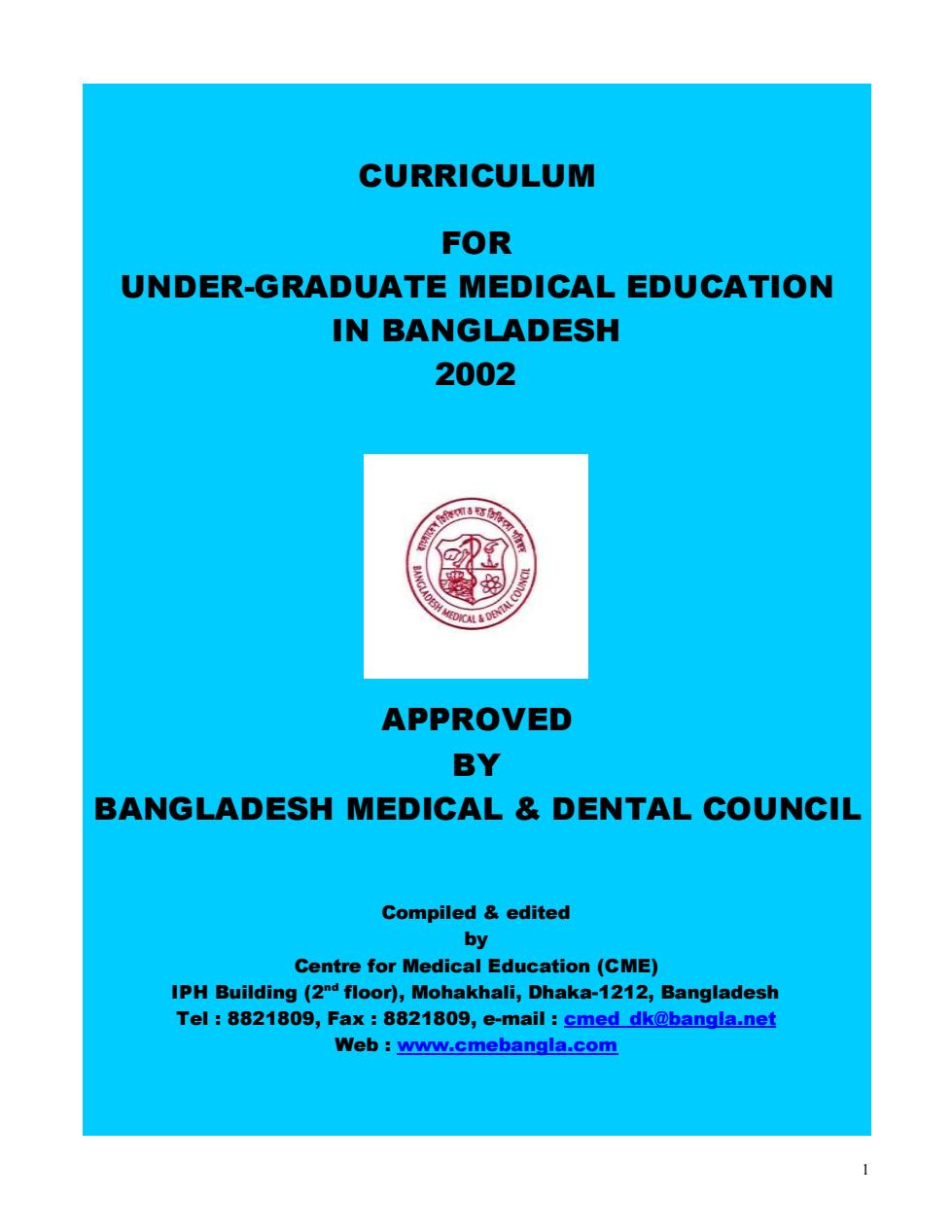
CURRICULUMFORUNDER-GRADUATEMEDICALEDUCATIONINBANGLADESH2002APPROVEDBYBANGLADESHMEDICAL&DENTALCOUNCILCompiled &editedbyCentreforMedical Education(CME)IPHBuilding(2ndfloor),Mohakhali,Dhaka-1212,BangladeshTel:8821809,Fax:8821809,e-mail :cmed dk@bangla.netWeb:www.cmebangla.com
1 CURRICULUM FOR UNDER-GRADUATE MEDICAL EDUCATION IN BANGLADESH 2002 APPROVED BY BANGLADESH MEDICAL & DENTAL COUNCIL Compiled & edited by Centre for Medical Education (CME) IPH Building (2nd floor), Mohakhali, Dhaka-1212, Bangladesh Tel : 8821809, Fax : 8821809, e-mail : cmed_dk@bangla.net Web : www.cmebangla.com
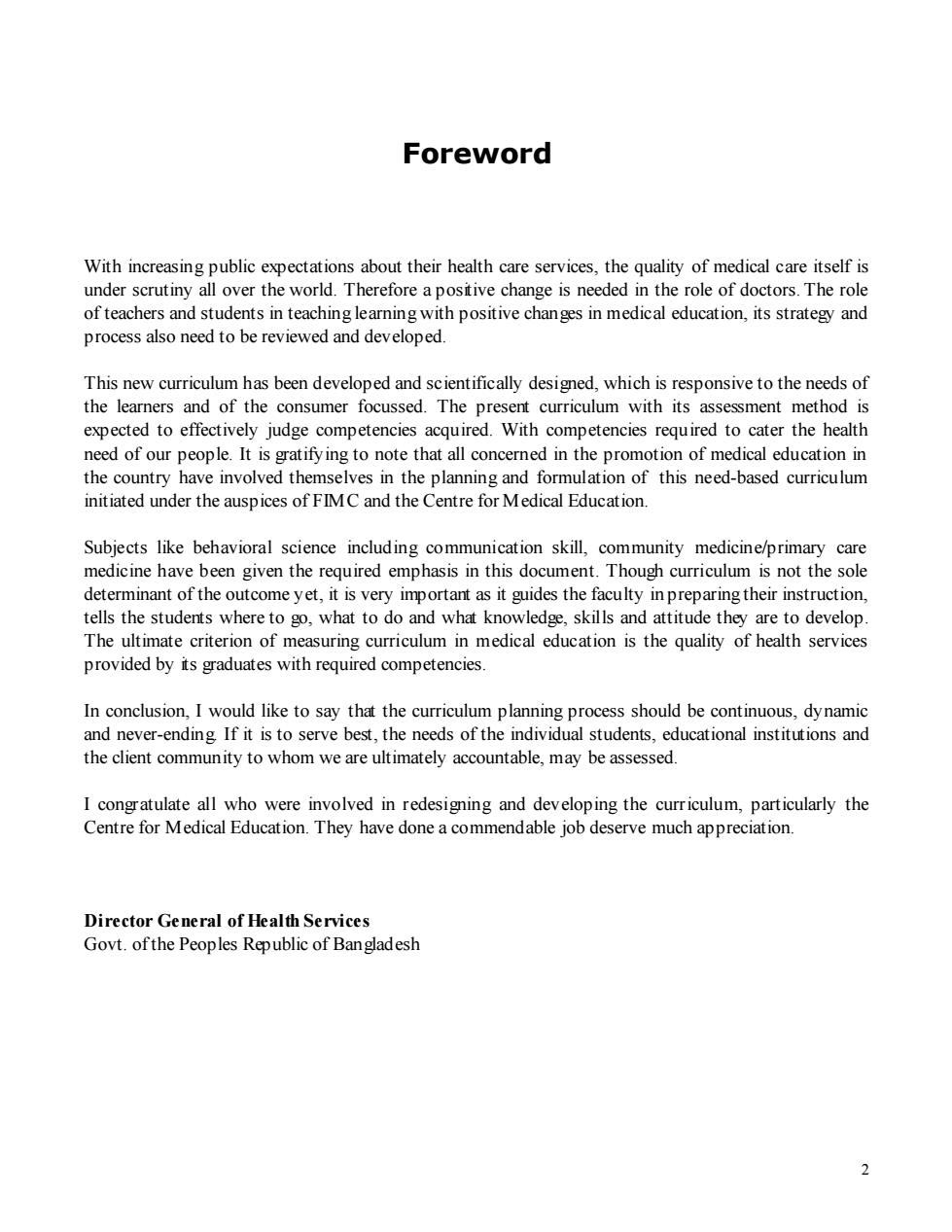
ForewordWith increasing public expectations about their health care services, the quality of medical care itself isunder scrutiny all over the world. Therefore a positive change is needed in the role of doctors. The roleof teachers and students in teaching learning with positive changes in medical education, its strategy andprocess also need to be reviewed and developed.Thisnew curriculumhasbeendevelopedand scientificallydesigned,whichisresponsivetotheneedsofthe learners and of the consumer focussed. The present curriculum with its assessment method isexpected to effectively judge competencies acquired. With competencies required to cater the healthneed of our people. It is gratifying to note that all concerned in the promotion of medical education inthe country have involved themselves in the planning and formulation of this need-based curriculuminitiated under the auspices of FIMC and the Centrefor Medical Education.Subjects like behavioral science including communication skill, community medicine/primary caremedicine have been given the required emphasis in this document. Though curriculum is not the soledeterminant of the outcome yet, it is very important as it guides the faculty in preparingtheir instruction,tells the students where to go, what to do and what knowledge, skills and attitude they are to develop.The ultimate criterion of measuring curriculum in medical education is the quality of health servicesprovided by its graduates with required competencies.In conclusion, I would like to say that the curriculum planning process should be continuous, dynamicand never-ending If it is to serve best, the needs of the individual students, educational institutions andthe client community to whom weareultimately accountable, may be assessed.I congratulate all who were involved in redesigning and developing the curriculum, particularly theCentrefor Medical Education.Theyhavedone a commendable jobdeservemuch appreciationDirectorGeneral ofHealthServicesGovt.ofthePeoplesRepublic of Bangladesh2
2 Foreword With increasing public expectations about their health care services, the quality of medical care itself is under scrutiny all over the world. Therefore a positive change is needed in the role of doctors. The role of teachers and students in teaching learning with positive changes in medical education, its strategy and process also need to be reviewed and developed. This new curriculum has been developed and scientifically designed, which is responsive to the needs of the learners and of the consumer focussed. The present curriculum with its assessment method is expected to effectively judge competencies acquired. With competencies required to cater the health need of our people. It is gratifying to note that all concerned in the promotion of medical education in the country have involved themselves in the planning and formulation of this need-based curriculum initiated under the auspices of FIMC and the Centre for Medical Education. Subjects like behavioral science including communication skill, community medicine/primary care medicine have been given the required emphasis in this document. Though curriculum is not the sole determinant of the outcome yet, it is very important as it guides the faculty in preparing their instruction, tells the students where to go, what to do and what knowledge, skills and attitude they are to develop. The ultimate criterion of measuring curriculum in medical education is the quality of health services provided by its graduates with required competencies. In conclusion, I would like to say that the curriculum planning process should be continuous, dynamic and never-ending. If it is to serve best, the needs of the individual students, educational institutions and the client community to whom we are ultimately accountable, may be assessed. I congratulate all who were involved in redesigning and developing the curriculum, particularly the Centre for Medical Education. They have done a commendable job deserve much appreciation. Director General of Health Services Govt. of the Peoples Republic of Bangladesh
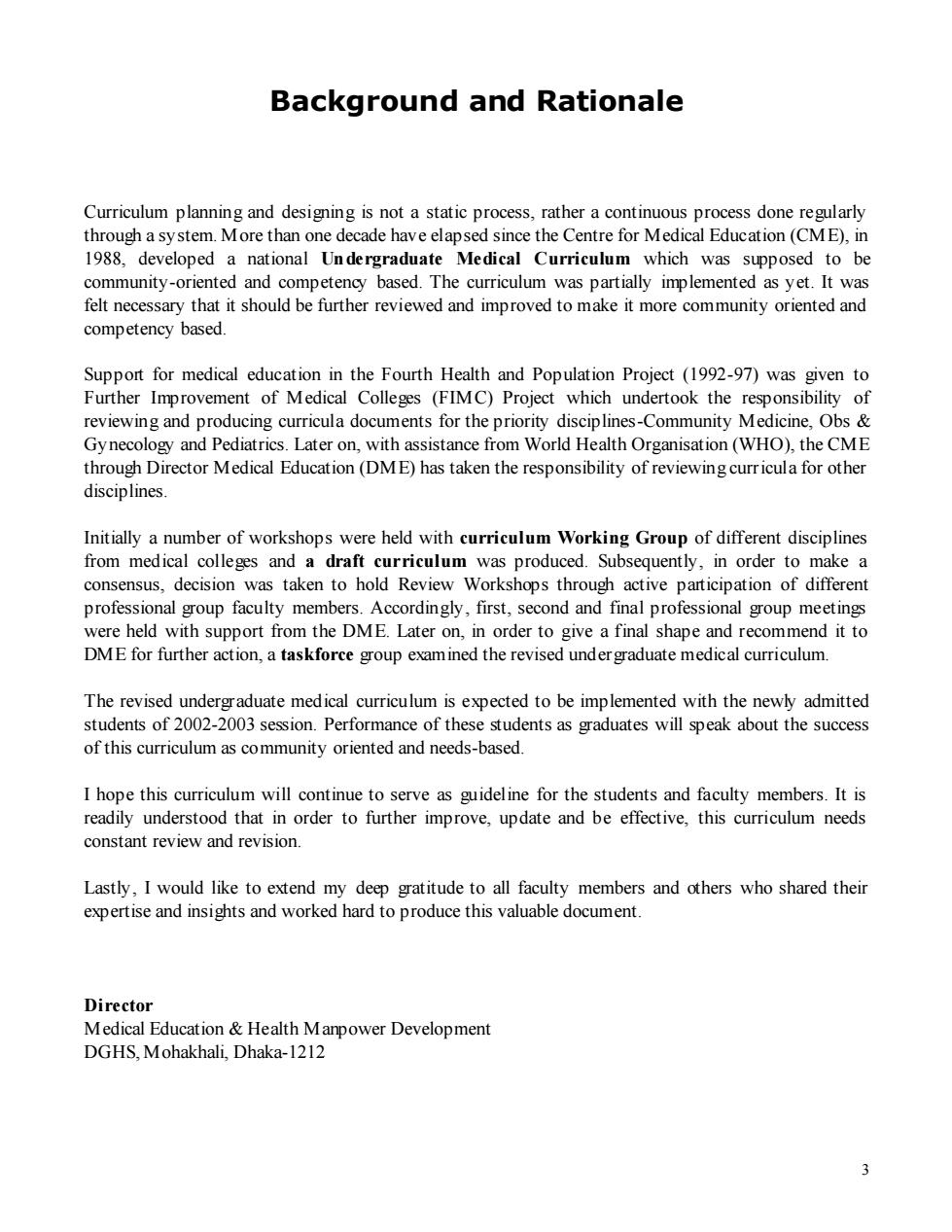
Background andRationaleCurriculum planning and designing is not a static process, rather a continuous process done regularlythrough a sy stem. More than one decade have elapsed since the Centre for Medical Education (CME), in1988, developed a national Undergraduate Medical Curriculum which was supposed to becommunity-oriented andcompetencybased.Thecurriculumwaspartiallyimplemented asyet.Itwasfelt necessary that it should be further reviewed and improved to make it more community oriented andcompetency based.Support for medical education in the Fourth Health and Population Project (1992-97) was given toFurther Improvement of Medical Colleges (FIMC) Project which undertook the responsibility ofreviewingandproducingcurriculadocumentsfortheprioritydisciplines-CommunityMedicine,Obs&Gynecology and Pediatrics. Later on, with assistance from World Health Organisation (WHO), the CMEthrough Director Medical Education (DME) has taken the responsibility of reviewing curricula for otherdisciplines.Initially a number of workshops were held with curriculum Working Group of different disciplinesfrom medical colleges and a draft curriculum was produced. Subsequently, in order to make aconsensus, decision was taken to hold Review Workshops through active participation of differentprofessional group faculty members. Accordingly, first, second and final professional group meetingswere held with support from the DME. Later on, in order to give a final shape and recommend it toDME for further action, a taskforce group examined the revised undergraduate medical curriculum.The revised undergraduate medical curriculum is expected to be implemented with the newly admittedstudents of 2002-2003 session. Performance of these students as graduates will speak about the successof this curriculum as community oriented and needs-basedI hope this curriculum will continue to serve as guideline for the students and faculty members. It isreadily understood that in order to further improve, update and be effective, this curriculum needsconstant review and revision.Lastly, I would like to extend my deep gratitude to all faculty members and others who shared theirexpertise and insights and worked hard to produce this valuable document.DirectorMedicalEducation&HealthManpowerDevelopmentDGHS, Mohakhali, Dhaka-1212
3 Background and Rationale Curriculum planning and designing is not a static process, rather a continuous process done regularly through a system. More than one decade have elapsed since the Centre for Medical Education (CME), in 1988, developed a national Undergraduate Medical Curriculum which was supposed to be community-oriented and competency based. The curriculum was partially implemented as yet. It was felt necessary that it should be further reviewed and improved to make it more community oriented and competency based. Support for medical education in the Fourth Health and Population Project (1992-97) was given to Further Improvement of Medical Colleges (FIMC) Project which undertook the responsibility of reviewing and producing curricula documents for the priority disciplines-Community Medicine, Obs & Gynecology and Pediatrics. Later on, with assistance from World Health Organisation (WHO), the CME through Director Medical Education (DME) has taken the responsibility of reviewing curricula for other disciplines. Initially a number of workshops were held with curriculum Working Group of different disciplines from medical colleges and a draft curriculum was produced. Subsequently, in order to make a consensus, decision was taken to hold Review Workshops through active participation of different professional group faculty members. Accordingly, first, second and final professional group meetings were held with support from the DME. Later on, in order to give a final shape and recommend it to DME for further action, a taskforce group examined the revised undergraduate medical curriculum. The revised undergraduate medical curriculum is expected to be implemented with the newly admitted students of 2002-2003 session. Performance of these students as graduates will speak about the success of this curriculum as community oriented and needs-based. I hope this curriculum will continue to serve as guideline for the students and faculty members. It is readily understood that in order to further improve, update and be effective, this curriculum needs constant review and revision. Lastly, I would like to extend my deep gratitude to all faculty members and others who shared their expertise and insights and worked hard to produce this valuable document. Director Medical Education & Health Manpower Development DGHS, Mohakhali, Dhaka-1212
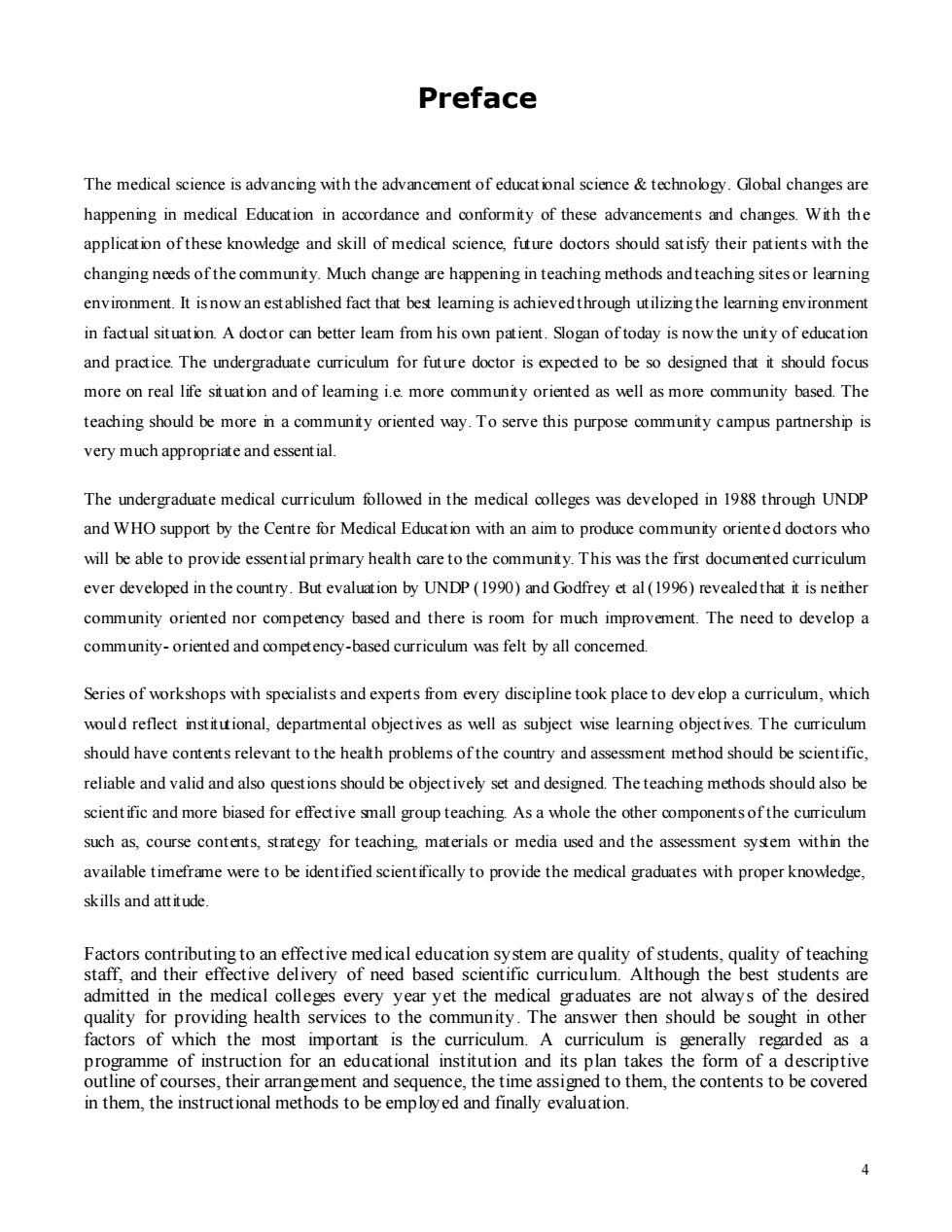
PrefaceThe medical science is advancing withthe advancement of educat ional science& technology.Global changes arehappeninginmedical Educationinaccordanceandconformityoftheseadvancementsandchanges.Withtheapplication ofthese knowledge and skill of medical science, future doctors should satisfy their patients with thechanging needs ofthecommunity.Much change are happening in teaching methods andteaching sites or learningenvironment. It is now an est ablished fact that best leaming is achievedthrough utilizingthe learning environmentin factual situation A doctor can better leam from his own patient.Slogan oftoday is now the unity of educationandpractice.Theundergraduatecurriculum forfuturedoctorisexpectedtobesodesignedthat itshouldfocusmore on real life situation and of leaming ie. more community oriented as well as more community based Theteaching should be more in a community oriented way. To serve this purpose community campus partnership isverymuchappropriateandessential.The undergraduate medical curriculum followed in the medical colleges was developed in 1988 through UNDPand WHO support by the Centre for Medical Education with an aim to produce community oriented doctors whowill beabletoprovideessentialprimaryhealthcaretothecommunity.Thiswasthefirstdocumentedcurriculumeverdevelopedinthecountry.ButevaluationbyUNDP(1990)andGodfreyetal(1996)revealedthatitisneithercommunity oriented nor competency based and there is room for much improvement. The need to develop acommunity-oriented and competency-based curriculum was felt by all concemed.Series of workshops with specialists and experts fom every discipline took place to develop a curriculum, whichwould reflect institutional, departmental objectives as well as subject wise learning objectives. The curiculumshould have contents relevant to the health problems ofthe country and assessment method should be scientific,reliableandvalid andalsoquestions shouldbeobjectivelyset and designedTheteachingmethods should alsobescientificandmorebiasedforeffectivesmallgroupteaching.Asawholetheothercomponentsofthecuriculumsuch as, course contents, strategy for teaching, materials or media used and the assessment system within theavailable timeframe were tobe identified scientificallytoprovide themedical graduates with properknowedge,skillsandattitude.Factors contributingto an effective medical education system arequality of students,quality ofteachingstaff, and their effective delivery of need based scientific curriculum. Although the best students areadmitted in themedical colleges everyyearyetthemedical graduates are notalways of the desiredquality for providing health services to the community.The answer then should be sought in otherfactorsof which themost important isthecurriculum.A curriculumisgenerallyregarded asaprogramme of instruction for an educational institution and its plan takes the form of a descriptiveoutline of courses, their arrangement and sequence, the time assigned to them, the contents to be coveredin them, the instructional methods to be employed and finally evaluation.4
4 Preface The medical science is advancing with the advancement of educational science & technology. Global changes are happening in medical Education in accordance and conformity of these advancements and changes. With th e application of these knowledge and skill of medical science, future doctors should satisfy their patients with the changing needs of the community. Much change are happening in teaching methods and teaching sites or learning environment. It is now an est ablished fact that best learning is achieved through utilizing the learning environment in factual situation. A doctor can better learn from his own patient. Slogan of today is now the unity of education and practice. The undergraduate curriculum for future doctor is expected to be so designed that it should focus more on real life situation and of learning i.e. more community oriented as well as more community based. The teaching should be more in a community oriented way. To serve this purpose community campus partnership is very much appropriate and essential. The undergraduate medical curriculum followed in the medical colleges was developed in 1988 through UNDP and WHO support by the Centre for Medical Education with an aim to produce community oriented doctors who will be able to provide essential primary health care to the community. This was the first documented curriculum ever developed in the country. But evaluation by UNDP (1990) and Godfrey et al (1996) revealed that it is neither community oriented nor competency based and there is room for much improvement. The need to develop a community- oriented and competency-based curriculum was felt by all concerned. Series of workshops with specialists and experts from every discipline took place to dev elop a curriculum, which would reflect institutional, departmental objectives as well as subject wise learning objectives. The curriculum should have contents relevant to the health problems of the country and assessment method should be scientific, reliable and valid and also questions should be objectively set and designed. The teaching methods should also be scientific and more biased for effective small group teaching. As a whole the other components of the curriculum such as, course contents, strategy for teaching, materials or media used and the assessment system within the available timeframe were to be identified scientifically to provide the medical graduates with proper knowledge, skills and attitude. Factors contributing to an effective medical education system are quality of students, quality of teaching staff, and their effective delivery of need based scientific curriculum. Although the best students are admitted in the medical colleges every year yet the medical graduates are not always of the desired quality for providing health services to the community. The answer then should be sought in other factors of which the most important is the curriculum. A curriculum is generally regarded as a programme of instruction for an educational institution and its plan takes the form of a descriptive outline of courses, their arrangement and sequence, the time assigned to them, the contents to be covered in them, the instructional methods to be employed and finally evaluation
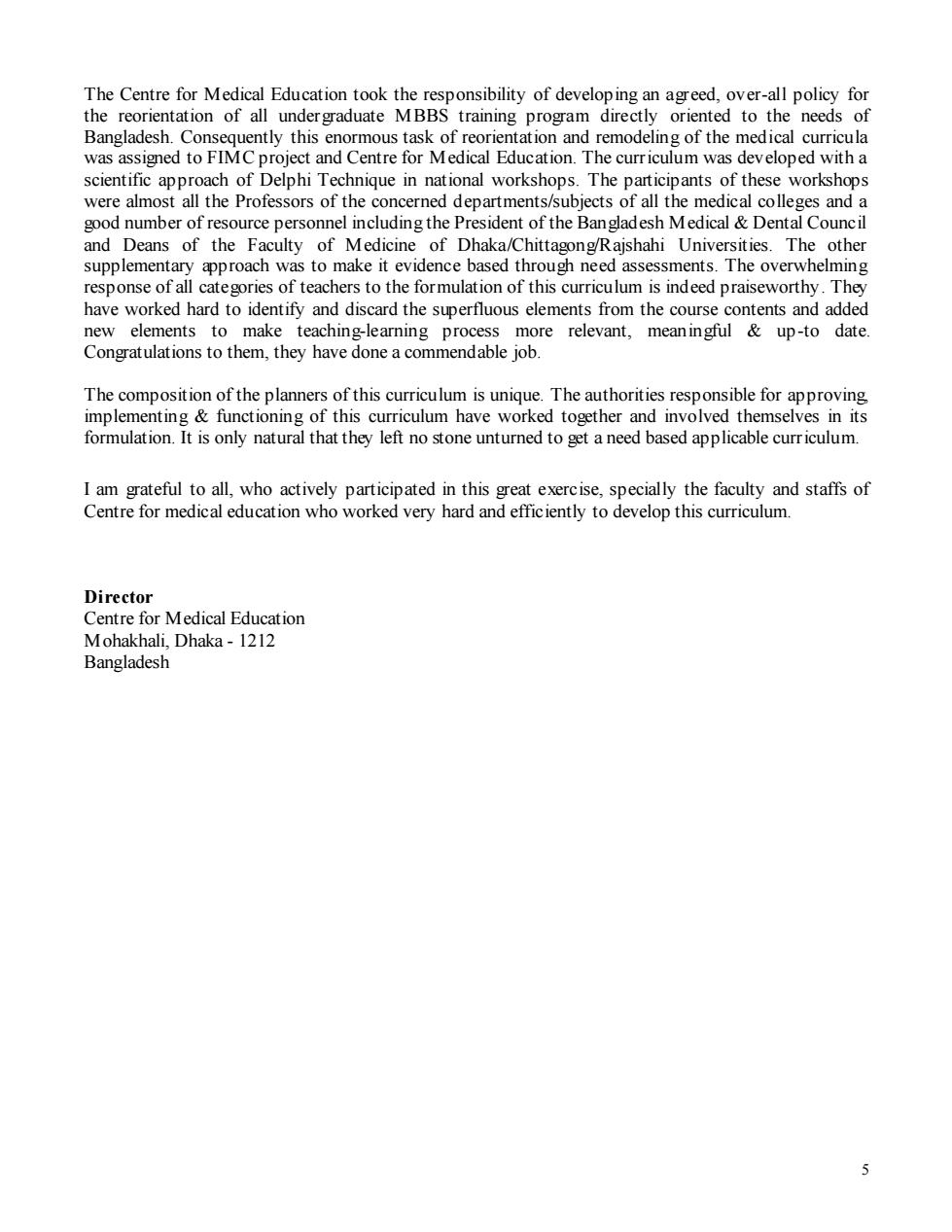
The Centre for Medical Education took the responsibility of developing an agreed, over-all policy forthe reorientation of all undergraduate MBBS training program directly oriented to the needs ofBangladesh. Consequently this enormous task of reorientation and remodeling of the medical curriculawas assigned toFIMCproject and Centrefor Medical Education.The curriculum was developed with ascientific approach of Delphi Technique in national workshops. The participants of these workshopswere almost all the Professors of the concerned departments/subjects of all the medical colleges and agood number of resource personnel including the President of the Bangladesh Medical &Dental Counciland Deans of the Faculty of Medicine of Dhaka/Chittagong/Rajshahi Universities. The othersupplementary approach was to make it evidence based through need assessments. The overwhelmingresponse ofall categories of teachers to the formulation of this curriculum is indeed praiseworthy.Theyhave worked hard to identify and discard the superfluous elements from the course contents and addednew elements tomake teaching-learning processmore relevant, meaningful &up-todate.Congratulations to them, they have done a commendable job.The composition of the planners of this curriculum is unique. The authorities responsible for approvingimplementing &functioning of this curriculum have worked together and involved themselves in itsformulation. It is only natural that they left no stone unturned to get a need based applicable curriculum.I am grateful to all, who actively participated in this great exercise, specially the faculty and staffs ofCentrefor medical education who worked very hard and efficiently to develop this curriculum.DirectorCentre for Medical EducationMohakhali, Dhaka - 1212Bangladesh5
5 The Centre for Medical Education took the responsibility of developing an agreed, over-all policy for the reorientation of all undergraduate MBBS training program directly oriented to the needs of Bangladesh. Consequently this enormous task of reorientation and remodeling of the medical curricula was assigned to FIMC project and Centre for Medical Education. The curriculum was developed with a scientific approach of Delphi Technique in national workshops. The participants of these workshops were almost all the Professors of the concerned departments/subjects of all the medical colleges and a good number of resource personnel including the President of the Bangladesh Medical & Dental Council and Deans of the Faculty of Medicine of Dhaka/Chittagong/Rajshahi Universities. The other supplementary approach was to make it evidence based through need assessments. The overwhelming response of all categories of teachers to the formulation of this curriculum is indeed praiseworthy. They have worked hard to identify and discard the superfluous elements from the course contents and added new elements to make teaching-learning process more relevant, meaningful & up-to date. Congratulations to them, they have done a commendable job. The composition of the planners of this curriculum is unique. The authorities responsible for approving, implementing & functioning of this curriculum have worked together and involved themselves in its formulation. It is only natural that they left no stone unturned to get a need based applicable curriculum. I am grateful to all, who actively participated in this great exercise, specially the faculty and staffs of Centre for medical education who worked very hard and efficiently to develop this curriculum. Director Centre for Medical Education Mohakhali, Dhaka - 1212 Bangladesh